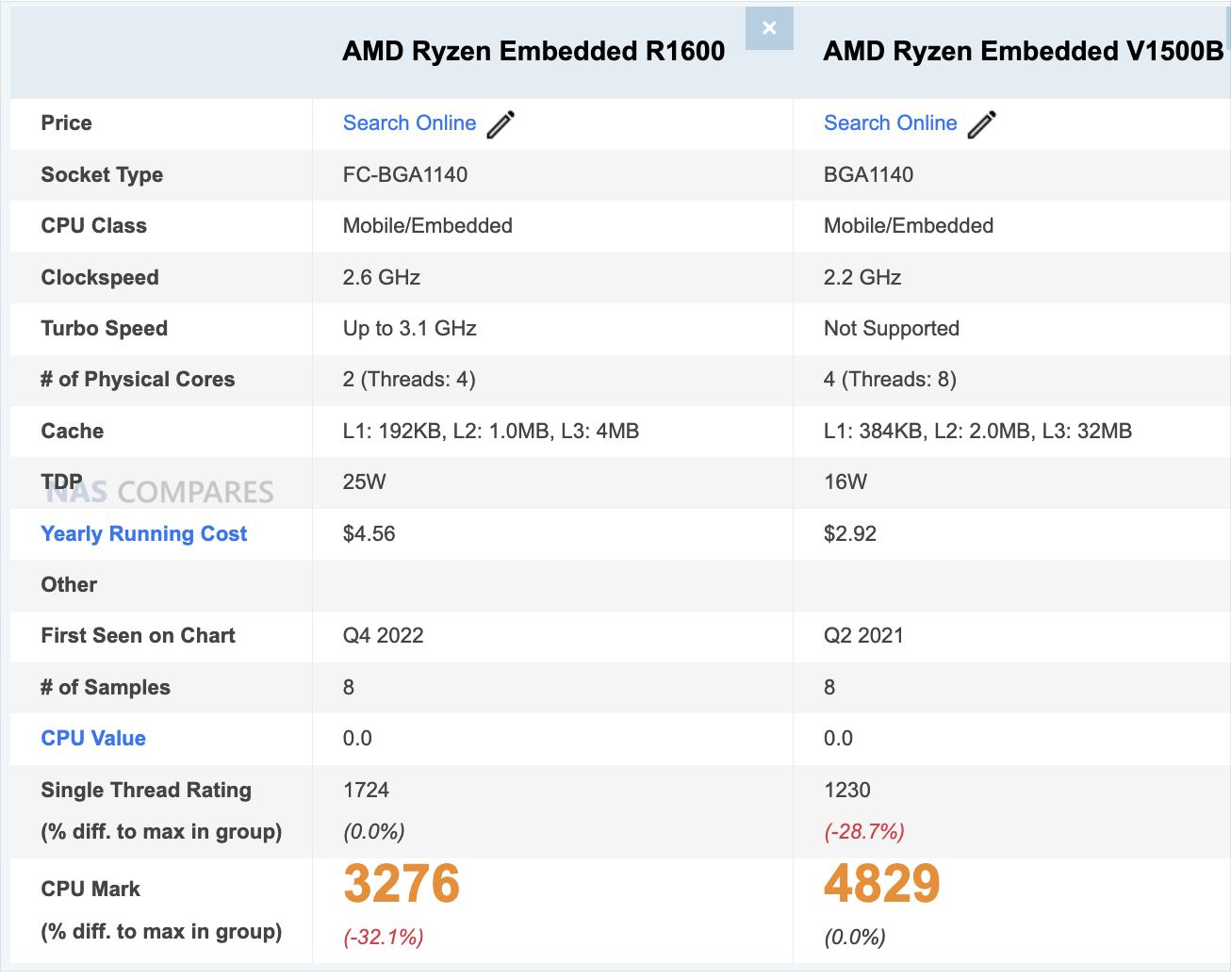The long-rumored Synology DS925+ is finally here, officially launching on May 7th, 2025. After months of speculation following leaks at Synology’s internal events and community buzz, we now have full visibility on this new 4-bay NAS model—including price, specs, and how it stacks up against its predecessor, the DS923+.
But with both units sitting at the same $550 MSRP, the big question is: Should you upgrade—or stick with the DS923+?
Let’s break it down.
What’s New in the DS925+?
|
|
||
|
PRICE |
£549.98 |
£550.97 |
|
CPU |
AMD Ryzen™ R1600 dual–core (4-thread) 2.60GHz/3.10 GHz Q2/2019 Passmark 3276 |
AMD V1500B (Quad-Core, 8 Threads) 2.20 GHz Q1/2018 Passmark 4829 |
|
GPU |
NO |
NO |
|
PCIE |
Gen3 / 8 lanes/ 7.9 GB/s |
Gen3 / 16 lanes/ 15.8 GB/s |
|
RAM |
4GB DDR4-2400 ECC (max 32 GB) |
4GB DDR4-2400 ECC (max 32 GB) |
|
SPEED |
2x1GBE + 10GbE / 12GBE |
2 x 2.5 GbE / 5GBE |
|
Expansion |
+5 with DX517 eSATA (6G) |
+5 with DX525 USB (6G) |
|
NVME |
gen3 |
gen3 |
|
HDD Compatibility |
3rd party |
? |
|
USB |
5Gbit |
5Gbit |
|
SUPPORT/ UPDATES |
2033 (8 years) |
2035 (10 years) |
CPU Comparison – More Threads, Less Clock
At first glance, the DS925+ appears to bring a clear performance upgrade:
-
The AMD V1500B in the DS925+ offers 4 cores and 8 threads, doubling the multi-threading capacity of the R1600.
-
However, it has a lower base frequency (2.2GHz vs 2.6GHz) and no turbo boost, unlike the R1600 which boosts up to 3.1GHz.
-
Based on PassMark scores, the V1500B does outperform the R1600 in multi-threaded workloads (Docker, VMs), but lags slightly in single-threaded performance—which affects day-to-day NAS operations like file indexing, metadata handling, and app responsiveness.
Verdict:
-
If you heavily rely on Docker, virtual machines, or multi-user access, the DS925+ will serve you better.
-
For general home use, the R1600 may actually feel snappier in lighter workloads due to higher single-core speeds.
Network Upgrades – Now with 2.5GbE (But…)
Synology has replaced the 1GbE ports with dual 2.5GbE on the DS925+—a welcome upgrade for users with faster local infrastructure. However, the benefit depends entirely on your environment:
-
WiFi users or those with 1GbE routers will see no speed gains.
-
For direct-attached networks or users with 2.5GbE switches, it can significantly improve RAW photo editing and large file transfers.
You can also combine both 2.5GbE ports using Link Aggregation or SMB Multichannel for up to 5Gbps throughput—though this requires network gear that supports it.
Expansion: USB-C vs eSATA
Another shift is the move from eSATA (DS923+) to USB-C (DS925+) for expansion:
-
The DX525 connects via USB, which some users fear may be more prone to accidental disconnection.
-
Synology claims identical speeds to the eSATA-based DX517, but real-world performance will tell the full story once units are in hand.
Still, the switch to USB-C may improve compatibility and future-proof the system in terms of accessories.
PCIe Slot Removed – No More 10GbE?
One of the biggest drawbacks of the DS925+ is the removal of the PCIe slot. This means:
-
No 10GbE upgrade path.

This is a big deal for power users, especially those transferring large media libraries or running multiple VMs. By contrast, the DS923+ supports 10GbE upgrades, giving it the edge for future-proofing in network throughput.
Memory and NVMe Support – No Major Change
Both models support:
-
DDR4 ECC memory, up to 32GB
-
NVMe cache via dual M.2 PCIe Gen 3 slots
However, neither supports NVMe storage pools unless using Synology’s proprietary NVMe SSDs. Additionally, Synology hasn’t made the leap to DDR5 RAM, which some competitors are already offering in newer NAS models.

Power Consumption and CPU Age
Interestingly, the V1500B is technically older than the R1600 (launched in 2018 vs. 2019), but it has better efficiency, with a TDP of just 16W compared to the R1600’s 25W.
This could lead to quieter operation, lower temperatures, and reduced power draw—especially in 24/7 workloads.
Plex and Multimedia – No Winner Here
Neither the DS923+ nor DS925+ has an integrated GPU, so hardware transcoding is off the table. You’ll be limited to 1080p streaming, and even that will rely on CPU-based transcoding.
If you need 4K Plex transcoding, you’ll either need:
-
A dedicated Plex server
-
A GPU-capable NAS (like QNAP with Intel CPUs)
-
Or get creative with external GPU mods (check out our separate video guide)
Support Cycle – Future-Proofing Matters
One reason to lean toward the DS925+ is the support timeline:
-
Synology offers up to 10 years of software updates per model.
-
The DS923+ was launched in late 2022, so it’s already 2+ years into its cycle.
-
The DS925+ is brand-new, giving you the full 10 years of firmware and security updates.
If you’re planning long-term deployment, this matters.

So… Should You Get the DS925+ or Keep the DS923+?
Go with the DS925+ if:
-
You’re planning multi-VM setups, running many Docker containers, or future-proofing.
-
You want better energy efficiency and slightly better multi-threaded performance.
-
You care about longer Synology support (10 years vs. 8 remaining for the DS923+).
-
You’re fine without 10GbE and happy with dual 2.5GbE.
Stick with the DS923+ if:
-
You already own it and don’t need 4C/8T CPU performance.
-
You need or plan to upgrade to 10GbE networking.
-
You find a good discounted price.
-
Your workload is light to moderate (home backups, media, basic Docker use).
Final Thoughts
The DS925+ isn’t a revolution—it’s an iteration. It refines some internals and modernizes connectivity, but it removes the PCIe upgrade path, which will be a dealbreaker for some.
If Synology had included 10GbE or GPU support, this would be a no-brainer. But in its current form, the DS925+ is great for virtualized environments and future-proofing, but not necessarily an upgrade for everyone.
If you’ve already got the DS923+ in hand, don’t feel left behind. But if you’re still deciding—the DS925+ might just be the better long-term bet.
| Where to Buy a Product | |||
|
|
    
|

|
VISIT RETAILER ➤ |
 |
    
|

|
VISIT RETAILER ➤ |
 |
    
|

|
VISIT RETAILER ➤ |
 |
    
|

|
VISIT RETAILER ➤ |
We use affiliate links on the blog allowing NAScompares information and advice service to be free of charge to you. Anything you purchase on the day you click on our links will generate a small commission which is used to run the website. Here is a link for Amazon and B&H. You can also get me a ☕ Ko-fi or old school Paypal. Thanks! To find out more about how to support this advice service check HERE
Why People Use TrueNAS, UnRAID and Proxmox to Turnkey NAS (Synology, QNAP, etc)
Why People Prefer Turnkey NAS vs TrueNAS, UnRAID and More
The Top 5 Mistakes NAS Buyers Make
Top 5 PLEX/Jellyfin NAS of 2025
Seagate Ironwolf vs WD Red NAS Hard Drives
The BEST NAS of 2025
Access content via Patreon or KO-FI
Discover more from NAS Compares
Subscribe to get the latest posts sent to your email.







DISCUSS with others your opinion about this subject.
ASK questions to NAS community
SHARE more details what you have found on this subject
IMPROVE this niche ecosystem, let us know what to change/fix on this site